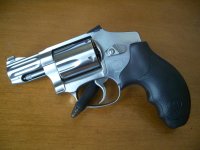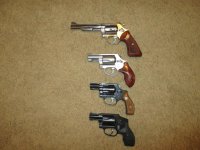I have a:
3" Model 60-15;
2 1/8" Model 60-14;
1 7/8" Model 36-10; and a
1 7/8" Model 36 no dash.
There's a pattern here - I prefer the steel frame J frame and J magnum frame revolvers.
A 2 1/8" stainless steel .357 Mag Model 60 in .357 will weight 22.6 oz and the 3" version will weight 24.5 oz.
A 1 7/8" scandium frame .357 Mag Model 360 will weight 13.3 oz, while the scandium framed .357 Mag 360PD with a scandium frame and titanium cylinder will weight just 11.4 oz.
The thing is that in a decent IWB holster and with a decent belt, the 24.5 oz weight of a 3" model 60 isn't noticeable even in all day carry, but that extra weight makes practical accuracy and comfortable shooting possible with .357 Magnum loads, and it's capable of 3" groups offhand at 25 yards if the shooter is good enough.
In contrast, a 11.4 oz or 13.3 oz .357 Magnum is appealing for pocket carry purposes due to the light weight, but it is not comfortable to shoot at all with .357 Magnum loads. In fact it's not even all that enjoyable with .38 + P loads.
A retired marine special operations friend of mine pocket carries a 340 and he readily admits that he carries .38s in it as .357 Mag just isn't practical in it, and he admits that it's a close range proposition even with .38s.
There is a substantial price to paid for the light weight each time you squeeze the trigger, so it really comes down to whether you want to carry and shoot your J-frame a lot, or just carry it.
You'll find lots of negative comment on the lock versus revolvers with no lock. Much of that is based on either diminished collector on the newer lock guns, and/or a long term grudge against what many perceived as S&W selling out to political interests installing the lock in the first place.
From a shooter perspective there are a couple reports of the lock engaging on it's own, but I've put thousands of rounds through my Model 60-14 and 60-15 and have never encountered the problem. The presence of the lock doesn't bother me at all. With an 8 year old in the house it even comes in handy now and then.
I do however prefer the lock on the -14 to the lock on the -15 as the lock on the -14 will engage with the hammer down, while the hammer has to be up on the -15.
As noted above J-frames with aluminum or scandium frames are not all that enjoyable or practical to shoot with .357 Magnum loads, and the recoil is such that the discomfort of shooting a number of rounds through them effectively keeps the .357 magnum round count in them low. If that were not the case, you'd start seeing a lot of cracked .357 J frames.
In general, even the steel J-Magnum frame revolvers are intended to be shot primarily with .38 Special and carried with .357 Magnum. The steel J-Magnum frame is at least more pleasant to shoot with .357 Magnum, provided you install a slightly larger Hogue or Pachmeyer grip, but even with the steel frame it won't tolerate a steady diet of .357 loads very well.
If you want to shoot a J frame sized pistol in .357 Magnum a lot, it's heresy to say it on an S&W forum, but you really want a Ruger SP101 in .357 Magnum. It's about 4 oz heavier and has a much heavier forcing cone, a stronger top strap, a stronger frame and a bit heavier barrel. It's more pleasant to shoot and it will stand up to a steady diet of .357 Magnum. My 3" SP 101 in .357 Mag is also hands down the most accurate small frame revolver I own.
In terms of .38 Special J frames, the steel J-magnum frame Model 36 is a pleasure to shoot with either standard pressure or +P .38 Special loads, and the terminal ballistics of a good .38 Special + P hollow point load are such that it makes a decent self defense round even in a short barrel .38. Standard pressure loads in a 1 7/8" or 2 1/8" .38 Special are not quite up to the task.
There are a lot of steel frame Model 36s out there that predate the official blessing for +P loads, but there is pretty much universal agreement that carrying +P loads in them for self defense purposes is just fine and you can still find an older Model 36 or 36-1 in excellent condition for reasonable money.
Occasionally I hear people whine that S&W ruined the J-frame with the J-Magnum frame, making it larger and heavier to carry, etc. Well...everyone has a right to their own opinion, but the differences are minor in terms of size and weight. The frame and cylinder are all of an 1/8" longer, the top strap is very slightly thicker and the radius between the back of the top strap and the top of the grip frame is larger, covering a bit more of the hammer. That's it - those are the differences and S&W didn't ruin anything for the shooter:
I'll make a final comment about pocket carry of the J-frame revolver, and in particular the enclosed and shrouded hammer versions.
The standard J-frame has a heavy enough and long enough DA trigger pull to reduce the chance of a negligent discharge occurring while you are holstering or pocketing the revolver - but I still highly recommend a pocket holster. It will enable you to holster the revolver while it is out in front of you in plain sight and without sweeping yourself, and then place the holster in your pocket with the trigger fully protected by the holster.
For IWB carry, I recommend a holster with a clip on it that will once again allow you to insert the revolver in the holster with the holster and revolver out in front of you where you can see it and avoid sweeping yourself.
I'm also a big fan of a hammer when conceal carrying a pistol. The argument for the enclosed hammer design is that it won't snag when drawn from a pocket, won't jam when fired from inside a purse, etc. Well, ok...but that's a much more theoretical than practical consideration. I've never had any problem pulling an exposed hammer J-frame out of a pocket, and if you're carrying in a purse, it needs to be in a purse designed for concealed carry with a separate compartment hold a revolver or pistol.
The problem with the enclosed hammer design is that you can't feel the hammer coming back of something is obstructing the trigger while you are holstering it - thus the holster advice above.
In comparison, with an exposed hammer design, you can both feel the hammer coming back if a trigger obstruction occurs, you can actively prevent it with pressure on the trigger due to the mechanical advantage, and you can physically prevent the hammer from coming far enough back to drop and ignite the round.
That adds a level of safety and it expands your safe holster options.
The shrouded hammer models split the difference. They won't allow you to physically block the hammer from coming back, but they will allow you to feel the hammer coming back and if you really feel the need for a covered hammer, this is a far better option for concealed carry than a fully enclosed hammer.
The exposed hammer design also offers the advantage of single action operation, allowing greater accuracy for most shooters at longer ranges - and make no mistake the J frame is combat accurate at 25 yards. With practice a DA trigger pull is not much of an impediment to accuracy once your trigger finger and grip strength is sufficient, but it's nice to have the SA option.










